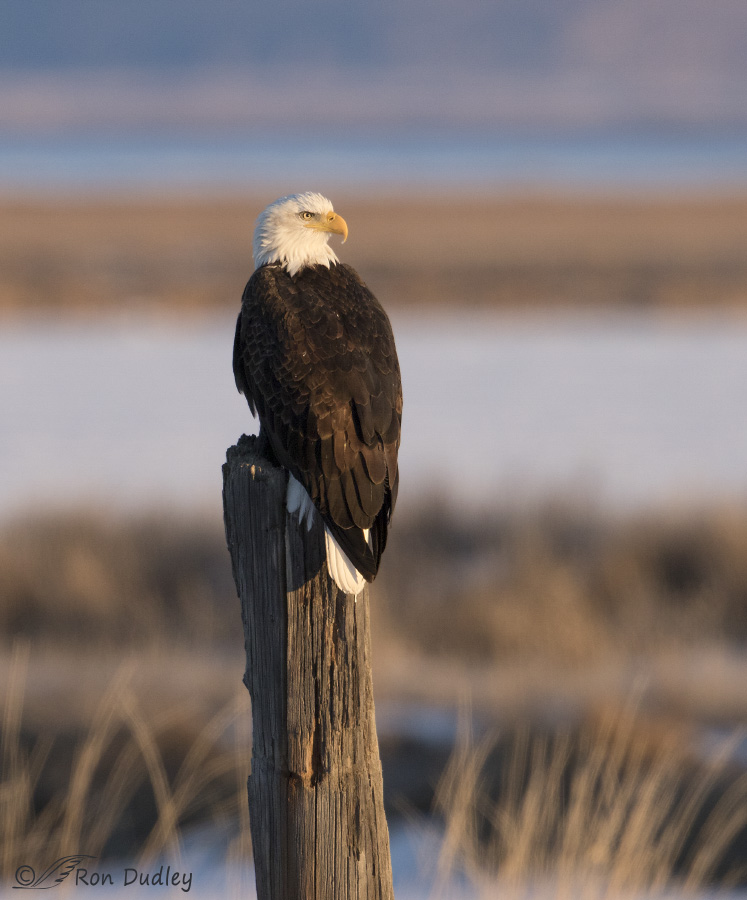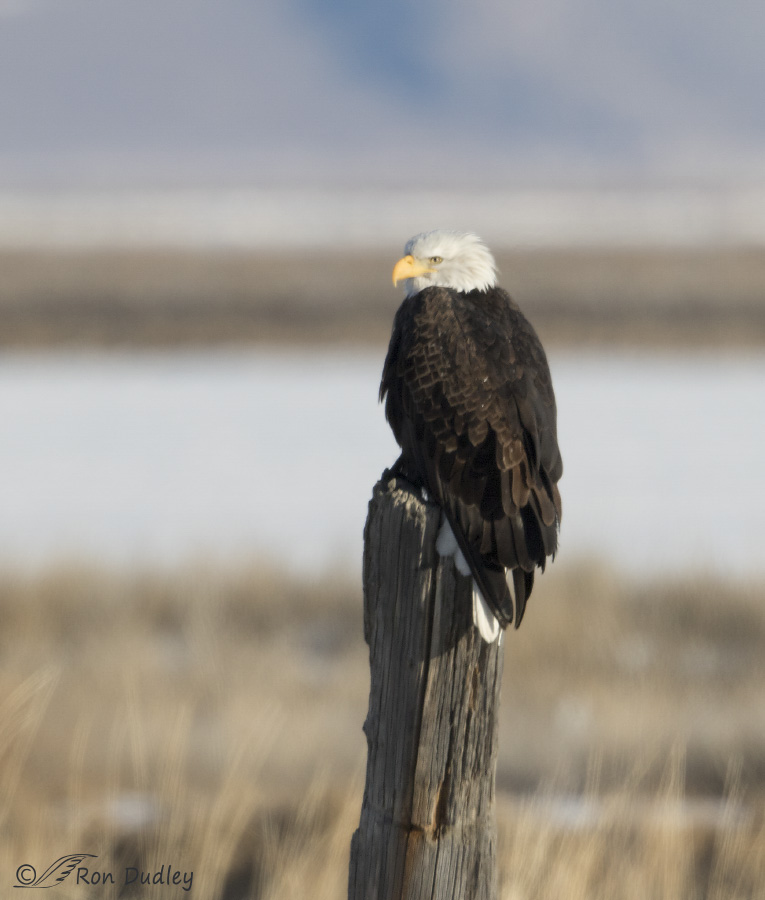Soft, warm light can have huge and usually positive effects on an image.
With birds it’s an effect that can be challenging to illustrate because they typically move around so much that it’s difficult to get photos of the same bird in the same place over large spans of time for comparison. After all, the best illustration of the effect would have only one variable- the time of day the images were taken. But yesterday morning at Bear River MBR this Bald Eagle gave me that opportunity.

1/1250, f/6.3, ISO 800, Canon 7D Mark II, Canon EF 500mm f/4L IS II USM + 1.4 tc, not baited, set up or called in
I first photographed the eagle on my way into the refuge just after sunrise at 8:16 AM. I love the warm light at that time of morning and in this image I also enjoy the multi-layered background. I wasn’t as close as I’d have preferred (the image is cropped to roughly 50% of the original) but I was about the right distance from the eagle for take-off shots so I stuck with the bird for a while. When it didn’t cooperate for flight shots I eventually moved on in pursuit of other birds.

1/2500, f/7.1, ISO 500, Canon 7D Mark II, Canon EF 500mm f/4L IS II USM + 1.4 tc, not baited, set up or called in
After a mostly unsuccessful tour of the loop road I left the refuge for destinations further north and was surprised to find the eagle still on the same post and in the same position, almost like it had been nailed to the perch. This image was taken at 9:28 AM, an hour and 12 minutes after the previous shot. The difference in light quality in that amount of time is dramatic. I was disappointed with what I saw through my viewfinder so I only took a couple of shots of the bird and none of them were very sharp but sharpness plays no significant part in the comparison of light between the two photos.
When I scroll back and forth between the two images I’m almost astounded at the differences between them (I made no tonal/color adjustments to either image during processing). Both were taken from approximately the same place on the road and the same distance from the bird. Like most everything else in an image light quality can be a matter of taste but there’s no question that I vastly prefer the first image and the primary reason for that is its light quality. In certain instances light can be too warm but for me that’s an unusual occurrence.
I’ve often said that I prefer to shoot early in the morning. Birds tend to be most active then, there are usually fewer other folks in the field to deal with, it’s much easier to get catch lights in the eyes of your subjects with the sun low in the sky, many birds tend to be “stickier” when it’s coldest during winter and I’m an early bird by nature anyway.
But warm, soft light is near the top of my list.
Ron


Very educational. 😀
The first picture is gorgeous. What a difference a hour will make.
Ron,
It was good to meet you yesterday. I had almost an identical experience this morning and I would bet it was the same eagle on the same post. Only I arrived just before sun up and the first images with sub-optimal light and stuck around until I got the golden light. I had 150 images before I quit pushing the shutter button. I knew it was going to be a pain deleting a bunch but I couldn’t help myself. Of course burst mode really loads the memory cars fast. I too stuck around waiting for him to take off and finally moved on.
Chad Merrell
I enjoyed meeting you too, Chad.
I’m pretty sure it was the same bird. I’d seen it (probably the same one) on the same perch once before a few days earlier but back then it was spookier and flew off before I could get any shots of it. I think it’s become acclimated to the traffic on the road.
Great illustration of the change, Ron.
As little as a few minutes can make a huge difference.
Nice work.
It sure can, Neil. Thank you.
As I type, dawn in sneaking in here. As a chronic insomniac I am addicted to the soft opening to the day that gentle light brings and LOVE (for a change) your depiction of the Bald Eagle in its gentle (and flattering) glow.
The fierce hunter (and scavenger) has its soft side too, EC.
Insomnia is a bi***, isn’t it?
Insomnia IS a dog of the female persuasion, but has bonuses too. I am very, very fond of the quiet and beauty of the dawn and pre-dawn hours.
And of course the Bald Eagle has its soft side. Don’t we all? Well concealed or not.
Beautiful color. I need to become an early riser on my days off. I tend to be a sunset girl.
Evening light works very well too, April. As long as the sun is low it’s all good…
I’m heading into my fourth year of attempting to photograph birds and, not surprisingly, have made the astonishing discovery that learning never stops (as with most things in life). However, I feel I took a step forward recently when I realized I was planning most trips to coincide with the time, location on the horizon and angle of the sunrise at specific spots. Images with that special light are head and feathers above those without it.
Thanks for the dramatic illustration, Ron!
“Images with that special light are head and feathers above those without it”
Love the way you said that, Wally! Thank you.
The difference in these images is quite striking. I’m with you in liking the first one better. At least for my eyes, I see far more detail in the soft light, and the bird is much more visible against the background.
“I see far more detail in the soft light”
Yup. Part of that’s due to the softness of the second image but fine shadows tend to be better defined with the sun low and not harsh so we often get better detail in light like this.
Really good example of lighting effects on image mood Ron. Thanks! The fact that the eagle perched in the same spot is also interesting — I will remember this the next time I have my lens on a perched eagle waiting for something to happen 🙂
Thanks, Ed. They either take off too soon or not at all, huh? 🙂
Wonderful shots Ron and the perfect illustration that light can be a photographer’s best friend or worst enemy.
Charlotte
“light can be a photographer’s best friend or worst enemy”
An interesting way to put it, Charlotte. Thank you.
Gorgeous! The warm light and the hint of the background REALLY make the picture “pop”. I’m with Dick – try to catch them any way I can! 🙂
“I’m with Dick – try to catch them any way I can!”
I agree, Judy – up to a point. We can take excellent images in many kinds of light and most any time of the day. But our chances of success (depending on how that word is defined) often improve dramatically when shooting birds with the sun relatively low in the sky.
WOW! That is a great lesson on warm light. Many times I try and catch a shot of my quarry any way I can, but these two shots show a definite difference. The warm shot is so pleasing to my eye and I see what you mean by the catch light. I’d almost say that the warm light has character and gives the shot a semblance of beauty all its own.
Many thanks for sharing.
“I’d almost say that the warm light has character and gives the shot a semblance of beauty all its own”
Well said, Dick. I agree.
There are times when extremely warm light can detract from an image but I don’t find that happening very often. One of the biggest problems with shooting fast moving birds in light like this is getting enough shutter speed.
WOW – WOW – WOW!!! Be still my heart!! My favorite Raptor in Golden light!! You’ve made my day, Ron!! I like both types of light. The white light gives true colors to any image and the warm light seems so beautifully sun lit (SP??) Thanks for a special start to my day, Ron!!
Jo Ann, natural light quality can be so hugely variable that I often wonder what “true colors” really are. I figured you might enjoy this bird!